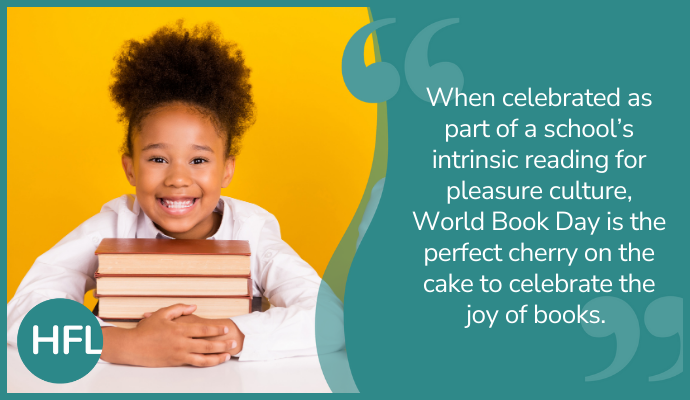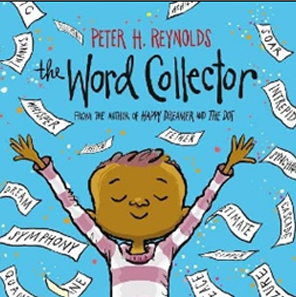
World Book Day is fast-approaching once again, and we are sure you’ll agree that there is nothing like a celebration to bring a community together – and what better way than in the name of reading! Of course, we love World Book Day and, when celebrated as part of a school’s intrinsic reading for pleasure culture, it’s the perfect cherry on the cake to celebrate the joy of books.
We know all too well the increasing pressures that fall upon our wonderful teachers and English leaders, and so we hope that this blog will provide you with some ideas and top tips to help promote a love of reading on World Book Day*… and every day!
Reading for Pleasure is the single most important indicator of a child’s future success (OECD, 2002)
First up: finding out about your young readers! Ideally before World Book Day rolls around, make sure that you know enough about your children and their reading identities. In order to talk about and recommend books, knowing what your children like (or don’t like!) to read is important. Conduct a quick survey with your class to find out more about their reading habits and identities. These questions have been borrowed from Jon Biddle, who has shared his practice on the Open University’s fantastic Reading for Pleasure website. They are suggestions that you could use or adapt as you wish:
- Write down three books that you have read in the last year.
- What is your favourite type of book (adventure, mystery, graphic novel, poetry, non-fiction, etc?)
- Can you name any children’s authors?
- Can you name any children’s poets?
- Do you enjoy reading in school? (Score 1 – 10: 1 = hate it; 10 = totally love it!)
- Do you enjoy reading at home? (Score 1 – 10: 1 = hate it; 10 = totally love it!)
- Are you a member of a local library?
- Do you enjoy an adult reading you stories? Why/ why not?
- How would you make reading more enjoyable in school?
- I read because….
- I would read more if….
- My teacher is a reader (true/ false)
- Tell me two interesting facts about you as a reader.
- Draw a picture which tells me something about you as a reader
The most important thing is that you follow-up pupil responses with conversations to find out more, and notice what they are trying to tell you about themselves and their identities as readers. How could their answers, and what you notice, inform how you approach not just World Book Day, but reading in general? Give greater attention to your more reluctant readers, focusing on those who may be disguising their reading struggles using different masking strategies.
Choosing books & creating wish lists
It is vital that we offer a rich reading diet which includes books that celebrate, represent, and appreciate the wonderful world around us, including the diverse community of the school. Remember the importance of books being ‘mirrors, windows and sliding doors’ – as the CLPE states in their latest Reflecting Realities report: ‘children need to meet characters that look like them – and those that don’t look like them, characters that inhabit similar – and different – worlds; stories that both reflect their lives and show them the lives of others.’
For more reluctant readers (and, in fact, for all readers), knowing and understanding their interests and experiences is key to unlocking their reading. It might be necessary to audit the books currently on offer in school to reflect on any gaps – but where to start?
- Ensure that there are a range of text types on offer: non-fiction books, poetry, graphic novels, and comics are equally important to fiction. Providing access to audiobooks is also a great idea, allowing children to tune in and listen to great prosody in action.
- Penguin & The Runnymede Trust’s ‘Lit in Colour’ is a fantastic website containing research and their report that highlights the systemic underrepresentation of Black, Asian and minority ethnic writers in the school curriculum. You can find their (incomplete!) Lit in Colour book lists here: Teaching resources (penguin.co.uk)
- If some children love graphic novels, Richard Ruddick @RuddickRichard) has generously shared a link to his Padlet which has some excellent recommendations: Graphic Novels (padlet.com).
- Books for Topics have also produced extremely useful ‘Branching Out’ posters which will help children to select a wider variety of books, based on their favourite authors.
- Use the ‘Grow Your Library’ resource, developed by colleagues at HFL Education (it can be downloaded)
- Delve deeper by reading more about the importance of diverse representation in the English curriculum.
Delve deeper by reading more about the importance of diverse representation in the English curriculum.
Engage the whole school community!
Why not select an awe-inspiring whole school text to focus on throughout the week? Wordless picture books are a fantastic way to spark curiosity and develop visual literacy across the age range. Here are just a few of our favourites:

Making connections through meaningful activities:
We know that children remember and enjoy books more when they are invested and can feel a personal connection to their reading. Here are some suggestions for activities that you might want to select from:
“You can’t force someone to love books, but you can tempt them to become a dedicated devourer of stories,” says Teresa Cremin (Teachwire).
Model the enjoyment of reading
Ask your school community to recommend favourite books. This could involve recommendations from children to staff, parents, governors and beyond! Holding a ‘Get Caught Reading’ event is another terrific way to spread those recommendations across school. A quick and easy way to showcase books the staff are reading is via whatimreading.org, where you can whip up a quick poster of the front cover and QR code for the community to find out more about a range of children’s literature. A note of caution though – if you do this, remember to change those ‘What I’m Reading’ posters frequently!
Create a sense of curiosity
Hold some clue-finding activities for children to guess books and characters. Many of our schools have created a ‘Masked Reader’ competition, inspired by the popular TV show ‘The Masked Singer/Dancer,’ where pupils must guess, “Who’s that behind the... book?”
Book blankets
Simply offer up a selection of tempting books (these can be placed on top of blankets or tablecloths on tables, to make this feel different and special) spread out around the classroom for the children to have a look at and talk about with each other. Set the children specific tasks, such as to find one book that interests them (asking them to explain why); one book that they would dismiss (also asking why that would be the case); one book by an author that they haven’t heard of before, and so on. You could even wrap some of the books in brown paper and write the blurb on the paper for children to select based on this – so that they are not dismissing them based on the front cover alone.
Book Buddies
Buddy up older and younger children in the school to read to each other and share their favourite books. Another excellent tool to have timetabled all year long!
The Great Book Swap!
Again, another great example to have set-up as a permanent fixture in school. World Book Day could be the perfect opportunity for a grand opening of your book swap area. Encourage the children to bring in a favourite book from home that they would like to share with their friends and swap with their peers’ favourite reads. This is a wonderful way to get that all-important, informal book talk happening.
Organise an inspiring author, poet, or illustrator visit
Or alternatively, bring in a performing arts company to bring a text to life in theatre form. Again, this is something that can happen at any time of the year, not just during the week of World Book Day. We would encourage you to pay particular attention to ensuring that you invite visitors from diverse cultures, backgrounds, and communities. There are also some wonderful, pre-recorded author talks available to watch at: Virtual Author Visit library | BookTrust and companies such as ‘Authors Aloud’ will arrange author visits for schools: Authors Aloud (authorsalouduk.co.uk)
Hold a book fair
This can be a fantastic way to develop a sense of excitement whilst boosting your school’s book collection through book rewards. There are many travelling book fairs that can be delivered straight to your school’s door and most will accept the £1 book tokens too. Planning a visit to your local library or supporting a local bookshop can also build your reading community.
Meaningful fundraising!
Book Trust research revealed that, “In the UK, nearly 400,000 children don’t have a book of their own. Having access to books and developing a love of reading for pleasure is vital for a child’s future.” Visit the fundraising section on the World Book Day website to find out how you can help to connect the school community to the power of reading.
What about dressing up?
Of course, we can’t talk about World Book Day without mentioning dressing up. Some children and families will absolutely love the idea of dressing up, whereas for others, this can become a source of stress (and dare we say it, may not always be about reading or books!). Instead, why not...
- Dress as a word! Create a vocabulary focus across school with pupils (and staff) dressing up as a word of their choice and plan a word-rich day around this theme. Encourage them to be adventurous with their vocabulary choices - their word could even describe their favourite book characters: courageous; mischievous; bright; sluggish; enthralling; intriguing… A delightful book link for this is ‘The Word Collector’ By Peter H. Reynolds.

- The children could snuggle up with a good book by participating in a pyjama day, focusing on the habit of daily bedtime reading. Invite parents into school to share stories as children enjoy reading and feeling relaxed, whilst being surrounded by a wonderful selection of books to share and discuss.
- Offer the chance to dress up as a class, so that no one misses out, by creating costumes in class beforehand. There are lovely suggestions available on the WBD website for this: World Book Day dress up ideas
Whatever you decide is best for your school, ensure that promoting your children’s love of reading and literature remains the focus. Encourage your readers to share their favourite texts, finding time for discussions, recommendations, and opportunities to bring texts to life using varied and diverse approaches.

Blog authored by Kayleigh Valentini and Ellen Counter.



